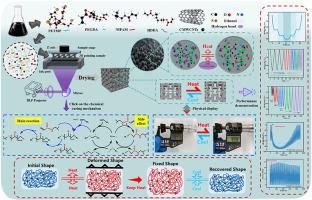用于高温多模态监测的基于巯基4D打印的抗疲劳自适应压力传感器
IF 14.2
1区 材料科学
Q1 ENGINEERING, MULTIDISCIPLINARY
引用次数: 0
摘要
高温工业环境对自适应传感器提出了重大挑战,实现高精度压力/温度双模式检测的关键问题是解决这些挑战。本研究创新性地开发了一种基于巯基点击化学和数字光处理(DLP) 4D打印技术的高性能自适应压力传感器。采用季戊四醇四(3-巯基丙酸酯)(PETMP)/聚乙二醇二丙烯酸酯(PEGDA)/ n -异丙基丙烯酰胺(NIPAM)/1,6-己二醇二丙烯酸酯(HDDA)的季系反应体系,构建了具有动态氢键和共价交联网络的双网络结构。硫醚键提供的高热稳定性与NIPAM相变驱动的动态氢键重组之间的协同作用使材料具有优异的温度响应性能(形状固定比Rf = 88.5±3.0%,形状恢复比Rr = 90.6±3.1%)。均匀分散的羧化多壁碳纳米管(CMWCNTs)通过氢键形成的三维导电/热网络进一步提供了信号传输的稳定性。采用DLP技术精密制造的仿生折叠孔结构通过几何应变放大效应显著增强了传感性能,实现了12.1%的大变形,- 0.143 kPa - 1的高灵敏度,62.2 ms的快速响应时间和超过2000次循环的优异抗疲劳性能,在高温预警监测和运动模式识别等多模态检测应用中表现出出色的性能。从分子设计到宏观结构的多尺度协同设计策略为工业生产监控传感器和智能预警系统的制造提供了一种创新的解决方案。本文章由计算机程序翻译,如有差异,请以英文原文为准。

Fatigue-resistant and adaptive pressure sensor based on thiol-ene 4D printing for high-temperature multimodal monitoring
High-temperature industrial environments pose significant challenges for adaptive sensors, where critical issues in achieving high-precision pressure/temperature dual-mode detection are used address these challenges. Herein, this study innovatively developed a high-performance adaptive pressure sensor based on thiol-ene click chemistry and digital light processing (DLP) 4D printing technology. A quaternary reaction system comprising pentaerythritol tetra(3-mercaptopropionate) (PETMP)/poly (ethylene glycol) diacrylate (PEGDA)/N-isopropylacrylamide (NIPAM)/1,6-hexanediol diacrylate (HDDA) was employed to construct a dual-network structure featuring dynamic hydrogen bonds and covalent crosslinking networks. The synergistic effect between the high thermal stability provided by thioether bonds and the dynamic hydrogen bond reorganization driven by NIPAM phase transition endowed the material with exceptional temperature-responsive properties (shape fixity ratio Rf = 88.5 ± 3.0 %, shape recovery ratio Rr = 90.6 ± 3.1 %). The three-dimensional conductive/thermal network formed by uniformly dispersed carboxylated multi-walled carbon nanotubes (CMWCNTs) through hydrogen bonding further provided signal transmission stability. The bioinspired folded hole structure precisely fabricated by DLP technology significantly enhanced sensing performance through geometric strain amplification effects, achieving large deformations of 12.1 %, high sensitivity of −0.143 kPa−1, fast response time of 62.2 ms, and excellent fatigue resistance exceeding 2000 cycles, demonstrating outstanding performance in multimodal detection applications such as high-temperature warning monitoring and motion pattern recognition. The multiscale cooperative design strategy spanning from molecular design to macroscopic structures provides an innovative solution for fabrication of industrial production monitoring sensors and intelligent warning systems.
求助全文
通过发布文献求助,成功后即可免费获取论文全文。
去求助
来源期刊

Composites Part B: Engineering
工程技术-材料科学:复合
CiteScore
24.40
自引率
11.50%
发文量
784
审稿时长
21 days
期刊介绍:
Composites Part B: Engineering is a journal that publishes impactful research of high quality on composite materials. This research is supported by fundamental mechanics and materials science and engineering approaches. The targeted research can cover a wide range of length scales, ranging from nano to micro and meso, and even to the full product and structure level. The journal specifically focuses on engineering applications that involve high performance composites. These applications can range from low volume and high cost to high volume and low cost composite development.
The main goal of the journal is to provide a platform for the prompt publication of original and high quality research. The emphasis is on design, development, modeling, validation, and manufacturing of engineering details and concepts. The journal welcomes both basic research papers and proposals for review articles. Authors are encouraged to address challenges across various application areas. These areas include, but are not limited to, aerospace, automotive, and other surface transportation. The journal also covers energy-related applications, with a focus on renewable energy. Other application areas include infrastructure, off-shore and maritime projects, health care technology, and recreational products.
 求助内容:
求助内容: 应助结果提醒方式:
应助结果提醒方式:


